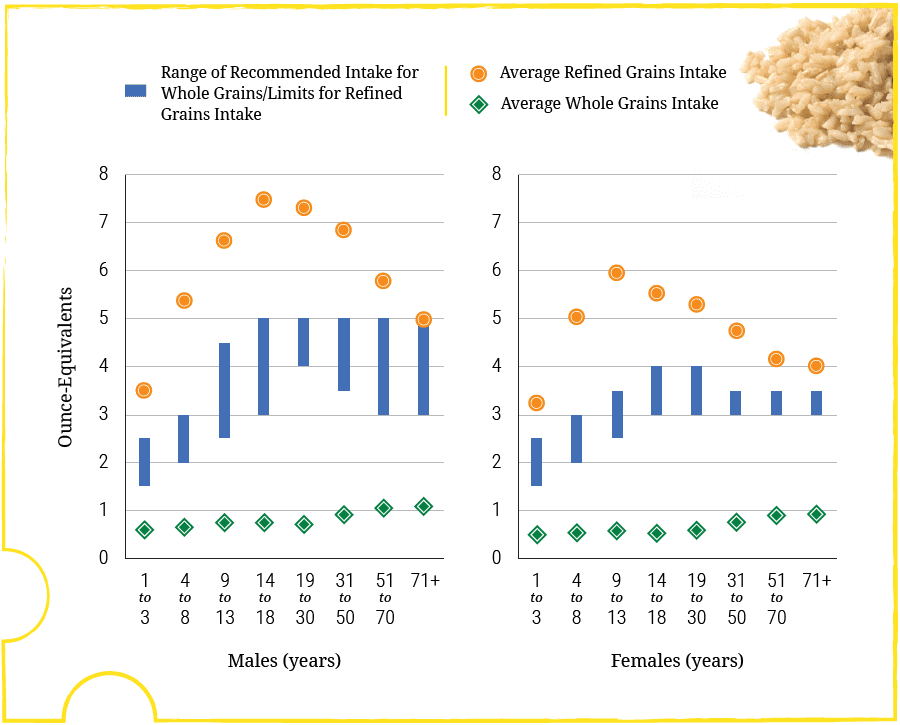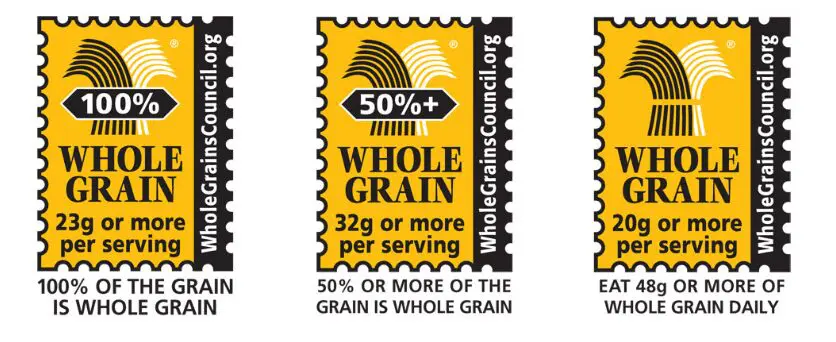Enriched vs Whole Grains
Whole Grain
Feel like identifying whole grains is a bit of a mystery? Looking to add more whole grains to your diet but not sure where to start? The Dietary Guidelines for Americans and MyPlate state that we should aim to make at least half of all grains consumed in a day whole grains. Consuming whole grains as part of a healthy diet may reduce the risk of heart disease, reduce constipation, help with weight management and prevent neural tube defects from forming during fetal development. The Dietary Guidelines for Americans reveal that Americans are falling short on this goal.

Many people may think they are consuming whole grains when in fact they aren’t due to marketing gimmicks. Identifying whole grains can take some detective work but using the following information you’ll be well on your way to incorporating more whole grains into your diet!
What is a whole grain?
All grains start out as a whole grain. Whole grains contain the entire seed (kernel) of a plant and are made up of three edible parts, the bran, the germ, and the endosperm. As long as a grain contains all three portions (even after processing) then the grain is considered a whole grain. Examples of whole grains include whole wheat flour, oatmeal, whole cornmeal, brown rice, quinoa, and bulgur. For a more inclusive list of whole grains visit Whole Grains Council.
If a grain is not a whole grain then it is considered a refined grain. This means that the nutrient-rich bran and germ have been removed during processing. The majority of refined grains are enriched, meaning they have B vitamins (thiamin, riboflavin, niacin, folic acid) and iron added after processing. The added folic acid can reduce certain birth defects of the brain and spinal cord. However, not all nutrients are replaced in enriched products. For example, fiber is not added back to enriched grains. Some examples of refined grains are white flour, white rice, white bread, bran or wheat germ. While these types of grains are not considered a whole grain, they can still be a part of a healthy diet and are important for women of child-bearing age.
100% Whole Grains vs Whole Grain-Rich
What’s the difference between 100% whole grain and whole grain-rich? Grains that are made with 100% whole grains can hold the claim that their products are 100% whole grain. Grains that are whole grain-rich must contain at least 50 percent whole grains; therefore, the first grain ingredient in the ingredient list on the nutrition facts label must be a whole grain to be considered whole grain-rich. While there may be other grains that are not whole grain in the product, the majority of grains are whole grain; therefore, the product is considered whole grain-rich.
Whole Grains vs Whole Wheat
Many people wonder if there is a difference between whole wheat and whole grain. Whole wheat is one kind of a whole grain. Other examples of whole grains include oats, whole cornmeal, quinoa, or brown rice. So while whole wheat is a whole grain, not all whole grains are whole wheat.
Identifying Whole Grain Products
There are a few ways to determine if a product is whole grain.
- Look for a Whole Grain Stamp. The 100% stamp assures that all of a products grain ingredients are whole grain while the 50% stamp ensures that at least half of its grain ingredients are whole grain. If a product has the basic stamp than it contains at least a half serving of whole grain per serving. The whole grain stamp is voluntary and is not required to be on products to be considered 100% whole grain or whole grain-rich.

- Package Label – If the package states that a product is 100% whole grain then the product is whole grain. Manufactures cannot use 100% whole grain on the label unless it truly is 100% whole grain.
- Nutrition Facts Label – Look at the ingredient list on the nutrition facts label. Choose foods that have a whole grain listed as the first ingredient on the label’s ingredient list. Ingredients are listed in order by weight. If the first ingredient listed is a whole grain (whole wheat flour, whole corn, etc.), the product is whole grain-rich. Checking the fiber on a label is not a reliable way to identify if a product is whole grain. Both fiber and whole grains have been shown to have health benefits, but they are not interchangeable.
Watch Out for these Tricks and Gimmicks
Foods labeled with words like “multi-grain,” “wheat or wheat flour,” “bran,” “organic flour,” and “made with whole grains” describe the package contents but do NOT mean the product is whole grain. Consumers must look at the ingredient list on the nutrition facts label to determine if the product is whole grain. Also, color is not an indication of whole grain, just because it looks “brown” like a whole grain does not mean that it is. Nuts or seeds on the top of bread also does not guarantee that a product is whole grain.
Arming yourself with this information will help you identify whole grains the next time you are at the store! Check out these resources if you are looking for some whole grain recipes or needing tips to increase whole grain consumption in your kids!
Love learning more about the nutrition behind your food? Check out our friends at the Wheat Foods Council! Or would you like to know a little bit more about where your food comes from? Take a look at the equipment used on the farm to grow the wheat for the bread your family eats.
Contributed by Jill Ladd, MPH, RD, LD